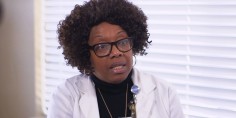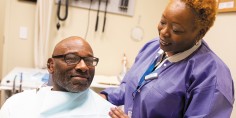With the pandemic forcing millions of Americans out of work and off employer-provided insurance plans, philanthropic support for health care access may be more important than ever. Guilford Community Care Network is among several access programs that the Endowment supports in the Carolinas. We spoke with Lisa Duck, its executive director, to see how her organization and its clients — particularly hard-hit minorities — are dealing with the pandemic.
Q. What is Guilford Community Care Network and what is its mission?
A. It’s a network of providers within the community that provides health care access to low-income uninsured persons in Guilford County. The network was created with the goal of linking uninsured or unassigned adults to a primary care medical home, either through our existing providers or through new clinics and resources that we’re able to obtain through recruitment.
Q. How does it function?
A. The network is a centralized point of entry bringing together health care agencies that are focused on the underserved population. We provide a safety net for adults who need services but can’t afford traditional private care. Folks who are enrolled receive an orange card that assigns them to a medical home and means they’ve been financially vetted to receive services throughout the network. Everyone we work with are at or below 200 percent of the federal poverty level.
Q. How many people have the cards?
A. On average, it’s about 3,000 clients per year. Our service goal is that we’re working to ensure that all persons have access to quality, comprehensive and affordable health care through innovative community partnership.
Q. Have you seen an increase in requests for service due to the pandemic?
A. Yes, on the care management side for sure. Our staff is receiving requests related to the social determinants of health — requests stemming from food insecurity, housing, utility disruptions and lack of transportation. The pandemic has changed our work in other important ways as well. Traditionally, folks would come in and meet with our enrollment counselors, but we moved very quickly to a virtual enrollment process. This has been one of the most successful initiatives that we’ve undertaken. Virtual enrollment from March to April increased by 20 percent and then by 27 percent from April to May.
Q. Did you have to upgrade your technology infrastructure?
A: Yes, and we’re still working to do that. We have moved to the GoToMeeting platform — and cell phones, of course, are always handy so we’re not missing any calls that come into the office.
Q. Are you doing telehealth appointments as well?
A. Yes. We are moving in that direction and I’m very happy to say that the vast majority of all of the safety net sites that we work with in Guilford County have moved or are moving to telehealth.
Q. Are patients comfortable with virtual consultations?
A. With a lot of our patients, there’s a huge fear factor about coming back into doctors’ offices. Introducing the telehealth model and using it to address any patient questions or concerns has been critical to helping them see that they can access our services in person if needed and feel safe.
Q. Some say low-income uninsured networks could see a decline in donated care from doctors because of the negative impact COVID-19 is having on their practices. Are you seeing that impact?
A. We haven’t seen a decline yet. We’ve still been able to get folks into their specialty care and primary care appointments. Still, we’ve had to think outside the box and use new avenues to reach out to providers safely. We actually just signed on a new provider. We were able to meet with the provider over GoToMeeting.
Q. COVID-19 is having a disproportionate impact on communities of color. Are you seeing that in your caseloads?
A. Probably not as heavily as some of the more densely populated areas, but yes. People of color are disproportionately underemployed, unemployed, and having to work multiple low- to medium-wage jobs that don’t cover or provide health insurance. Many people of color are also considered essential workers, meaning that they’re working in industries like food service or industries where you can’t necessarily work from home.
Q. What can be done to better protect communities of color?
A. I believe we need to look at expanding Medicaid coverage under the Affordable Care Act. I think that’s a factor. We also need to focus on testing, tracing and trending factors to make sure there are enough tests being performed in communities of color. We need to ensure they have access to those tests, and access to the medical care services needed. We also need to be able to trace contacts so we can isolate and stop clusters of infection. And we need to be able to see trends in our county- and community-level data so we know if cases are increasing, decreasing or remaining constant. In addition, we need to continue the community safety messaging around the importance of wearing your mask, social distancing, and washing your hands.
Q. It seems the pandemic has opened people’s eyes to how badly communities of color are affected by health disparities. Has it given you deeper insight?
A. I came into the pandemic knowing that not everyone had the same opportunity to live the same long and healthy life. I knew the quality of life was different for some people, especially for folks who are living in poverty every single day of their lives. The COVID-19 crisis has just more clearly exposed these realities.
We need to begin to address these health disparities now, so as we move toward a recovery, we can look at policy, advocacy and system level changes to address the systemic issues driving this.
Q. Where does the change start?
A. In the community, at the home and in the doctor’s office. We need to focus on empowering our patients to make healthy choices and to seek more preventative screenings. We need to be doing everything we can to expand preventative services and clinical settings. We need to focus on integrated care, bringing everyone together — the mental health community, your primary care setting, your oral healthcare setting.
Q. Are you seeing evidence of the digital divide with clients lacking internet access?
A. That was my initial greatest fear in March. In the last few months, I have seen that these networks and providers have moved to a broader form of telehealth — and for folks who may not have a computer, they’re working with them over the phone. No matter what situation that you come to us with, we’re able to assist you.
Q. Given all that’s happened in 2020, what gives you cause for hope?
A. The work that we do, it’s a mission of my heart. The low-income uninsured safety networks were already poised for this ever-changing landscape. We’re learning things as we go, which also creates a sense of inherited strength. We can help build stronger communities that reflect that diverse network of people we serve, but it’s going to take all of us learning together to impact this framework for health access equity.





